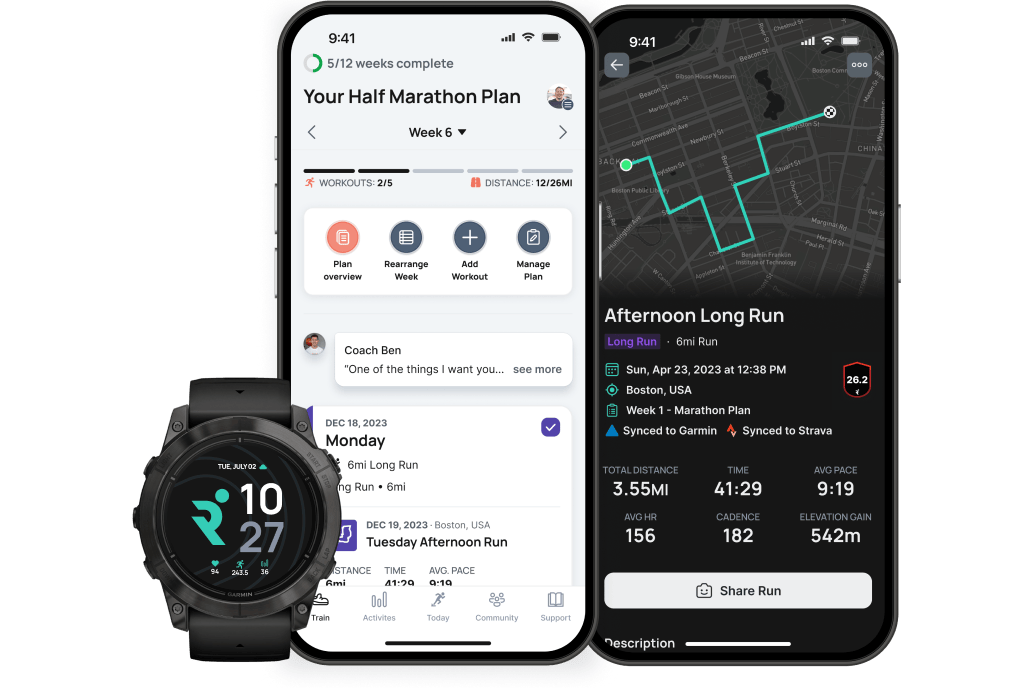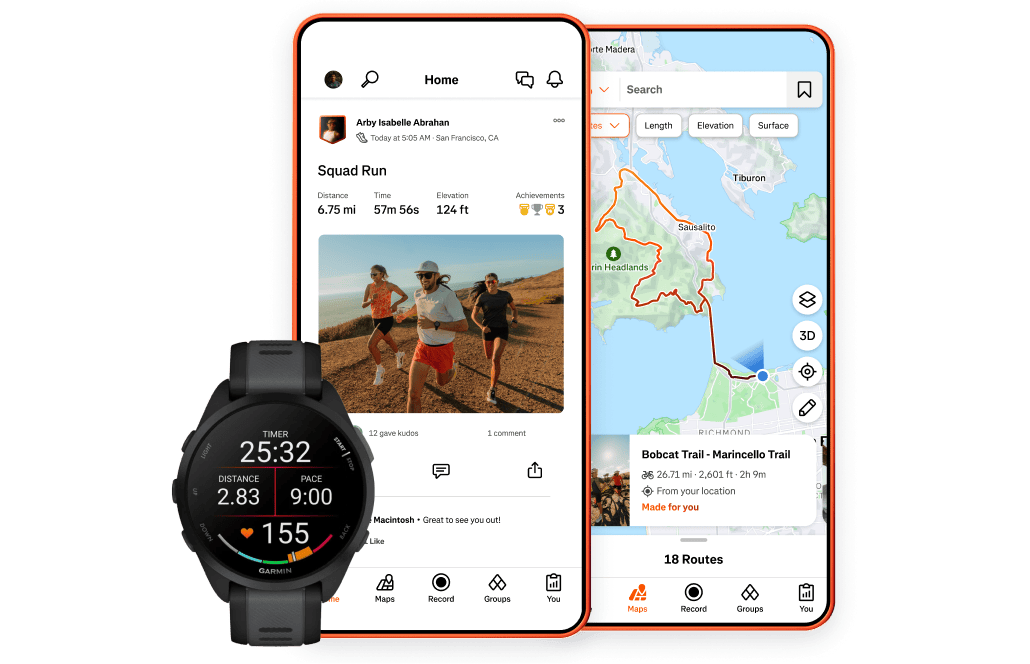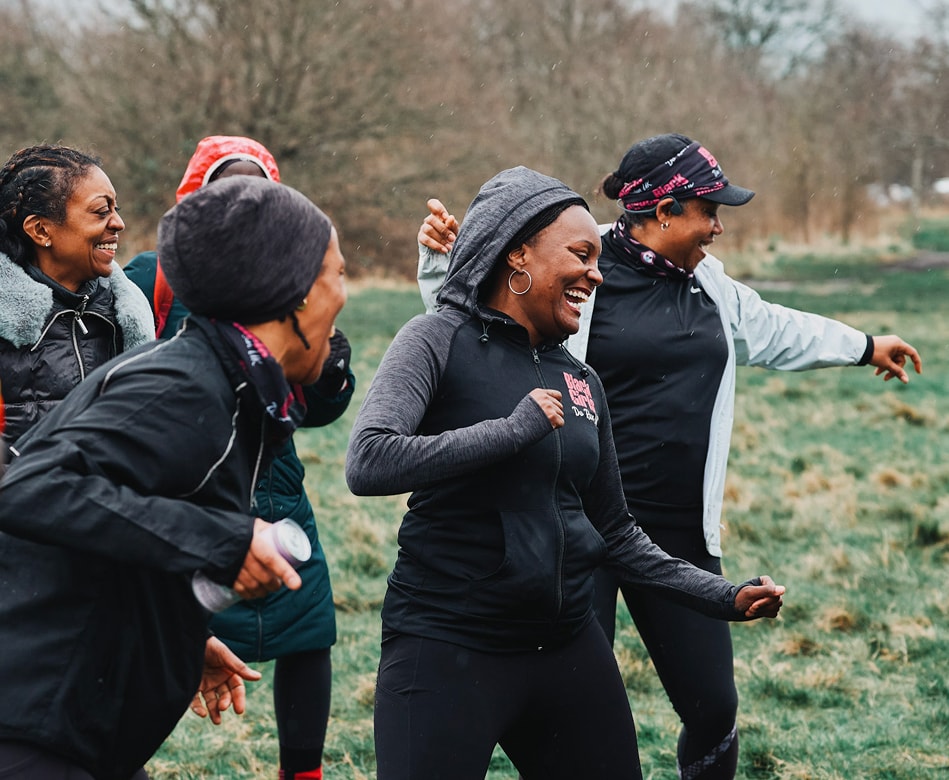vs
How they're different, similar, and work best together
Strava and Runna are both powerful tools for runners, offering support in different ways. They share some surface-level similarities: both are mobile apps that help people improve their fitness and track their workouts; they can connect to your GPS watch or phone; and both let you review progress over time.
However, they serve very different purposes. Strava is a social fitness tracking app, focused on sharing activities, joining clubs, and comparing efforts with others. Runna, on the other hand, is a personal running coach, built to deliver structured, goal-specific training plans with expert guidance.
Because of these differences, the two apps are highly complementary. You can use Runna to train smarter, while sharing your progress and celebrating milestones with your community on Strava.
Here, we deep-dive into:
Feature haves and have-nots for both
Runna premium features
Strava premium features
Shared features and overlapping benefits
Using both apps together (where the magic happens)
Feature list
Structured running training plans
Expert coaching guidance
Dynamic plan adjustments
Strength, mobility, and Pilates sessions
Beginner-friendly free running plans
Workout syncing with watches (Garmin, Apple, etc.)
Progress tracking and workout history
Follow and be followed by friends
Club communities and events
Segment leaderboards and competitions
Route discovery and planning
Multi-sport support (cycling, swimming, etc.)
Sync between the two apps
Runna premium
Runna sets itself apart by delivering professional, structured coaching that adapts to you personally. While Strava logs what you’ve done, Runna supports your training by showing you what to do next, providing a plan to follow with built-in adjustments for missed runs, changing race goals, or shifting schedules. The plans are designed by expert coaches and include not just runs, but also strength, mobility, and Pilates to keep you healthy and strong. Runna’s community feed keeps you connected with people on similar journeys, without the pressure of a traditional social network. It’s your personal coach, plan, and support network in one.

Structured training plans
Runna is designed around professional training plans, built for goals ranging from couch-to-5k to sub-3-hour marathons. You select a plan based on your goal, experience, and weekly availability, and the app builds a calendar of workouts that adapt over time.
Strava doesn’t offer structured plans by default. You can manually follow a plan, but there’s no built-in coaching experience.
Coaching expertise and guidance
Runna’s plans are created by experienced running coaches and offer explanations for each workout, tips on pacing, recovery advice, and training theory. This transforms it from a tracking tool into a true training companion.
Strava doesn’t include workout guidance, reasoning behind sessions, or any coaching content unless added via a third-party integration.
Adaptability and dynamic adjustments
If you miss a workout, go on holiday, or change your race date, Runna allows you to adjust your plan on the fly. You can shift your schedule, repeat weeks, or re-target a different event, and the app will rebuild your plan accordingly.
Strava doesn’t offer dynamic plan adjustments, since it isn’t built around training calendars.
Strength, mobility, and pilates
Beyond running, Runna includes sessions for strength training, mobility, and Pilates, all built specifically to support runners with injury prevention, recovery, and performance in mind.
Strava can log these types of sessions, but it doesn’t include pre-built workouts or instructional content.
Free intro plans and affordable coaching
Runna offers free beginner plans like “New to Running” and “Return to Running”, giving users a no-cost path to build their fitness. Paid plans provide more advanced features and full access to personalized training.
Strava also has a free tier, but most of its advanced features (like segment analysis, route building, and training data breakdowns) are locked behind a Premium subscription.
Strava subscription
Strava stands out for its broad social connectivity and multi-sport versatility, making it a go-to app for athletes of all types. While Runna focuses on structured coaching, Strava gives users a place to share their workouts, follow friends, and compete on segments no matter what sport they do, whether that’s running, cycling, swimming, hiking, or something else entirely. Its powerful route discovery tools, community clubs, and leaderboards help people stay motivated through friendly competition and connection. If you thrive on encouragement, kudos, and seeing what your friends are up to, Strava’s social tools are a clear advantage.

Activity tracking for dozens of sports
Strava supports more than just running. You can log cycling, hiking, swimming, skiing, rowing, gym workouts, and even manual entries for things like yoga or mobility. It’s built to be an all-sport journal for endurance athletes and weekend warriors alike.
Runna, in contrast, is built specifically for runners and includes targeted support for running, strength training, mobility, and Pilates, but doesn’t offer the multi-sport breadth that Strava does.
Segments and leaderboards
Strava's segment feature lets users compete over specific stretches of road or trail (e.g., a local hill or park loop). Each run automatically checks if you’ve run a segment and compares your time against others on the leaderboard.
Runna doesn’t include segments or community competition. It emphasizes individual performance and structured progression, rather than competitive tracking.
Clubs, events, and group challenges
Strava allows users to join clubs, whether they’re local running groups or global communities around brands or causes. Clubs can host events, post updates, and create group challenges to keep people engaged.
While Runna does offer team challenges and group plan options, especially for corporate wellness or partner integrations, it’s more limited than Strava’s large-scale, open club system.
Route building and discovery
Strava Premium includes a powerful route builder with heatmaps, elevation, and surface type indicators. It also allows you to discover popular running or cycling routes near you, based on millions of community uploads.
Runna doesn’t currently offer route planning or community-based discovery tools.
Social feed, following, and friends
Strava offers a fully developed social network for athletes. Users can follow friends, pro athletes, or clubs, and their feed updates in real-time with all public activities those people upload: runs, rides, swims, hikes, and even gym workouts. You can give "kudos" (likes), leave comments, and interact much like you would on Instagram or Facebook, but focused around fitness.
This kind of person-to-person connectivity is central to Strava’s identity. It’s designed to keep you engaged through your broader fitness circle, even if you’re not training together in person.
In contrast, Runna’s community feed is context-based. You don’t follow individuals, and you won’t see a global stream of activity. Instead, updates come from users in shared communities, like people training for the same race. It fosters a more focused and supportive environment, without the constant activity stream of a traditional social feed.
Shared features and overlapping benefits
Despite their different focuses, Runna and Strava do have overlapping functionality in a few areas:
- Workout syncing: Both apps can sync with GPS watches (Garmin, Apple Watch, Coros, etc.) and fitness platforms (Apple Health, Google Fit). You can also sync workouts between Runna and Strava, so your Strava followers can see your completed Runna sessions.
- Progress tracking: Both show historical logs, personal records, and training data. You can review your performance, pace, and trends over time in both apps.
- Goal-oriented usage: Whether you're chasing a faster 10k or just staying active, both apps help keep you on track in different ways: Strava through community, and Runna through structure.


Using Runna and Strava together
The real magic happens when you use Runna and Strava in tandem.
Use Runna to train smart: Follow a coach-built plan tailored to your goals and schedule, and incorporate strength and mobility work for well-rounded development.
Use Strava to stay motivated and social: Share your progress with friends, compete on segments, and track your streaks and personal records.
Because Runna workouts can automatically sync to Strava, your community can cheer you on, even as you follow a structured, private plan. This combination gives you both expert guidance and social support, making it easier to stay committed and consistent.

/Homepage/Runna_Phone_Screens_Watch.webp)